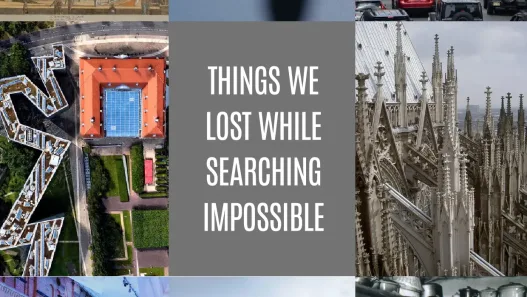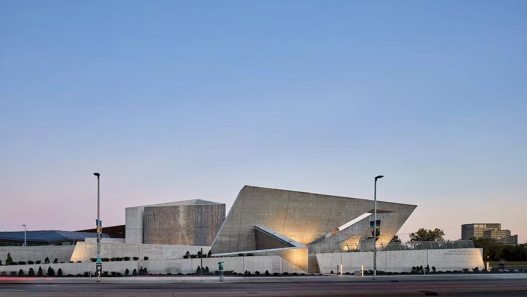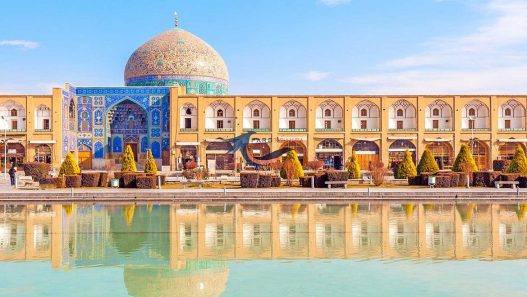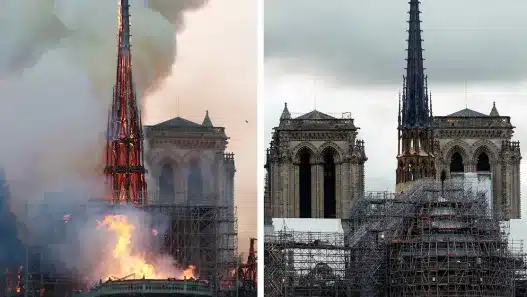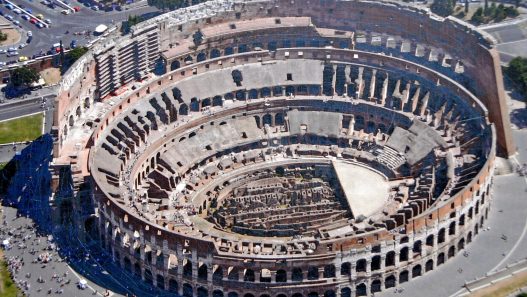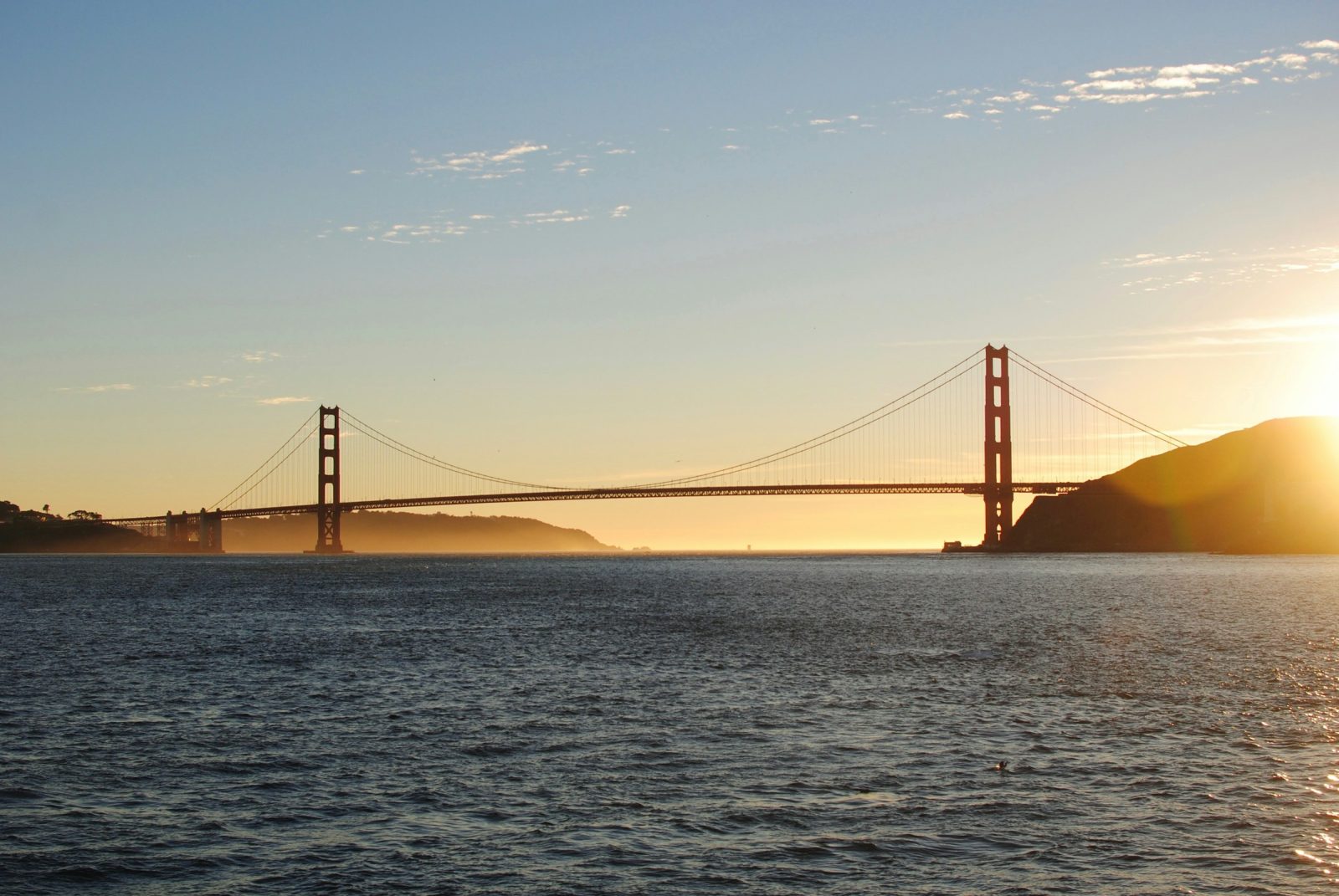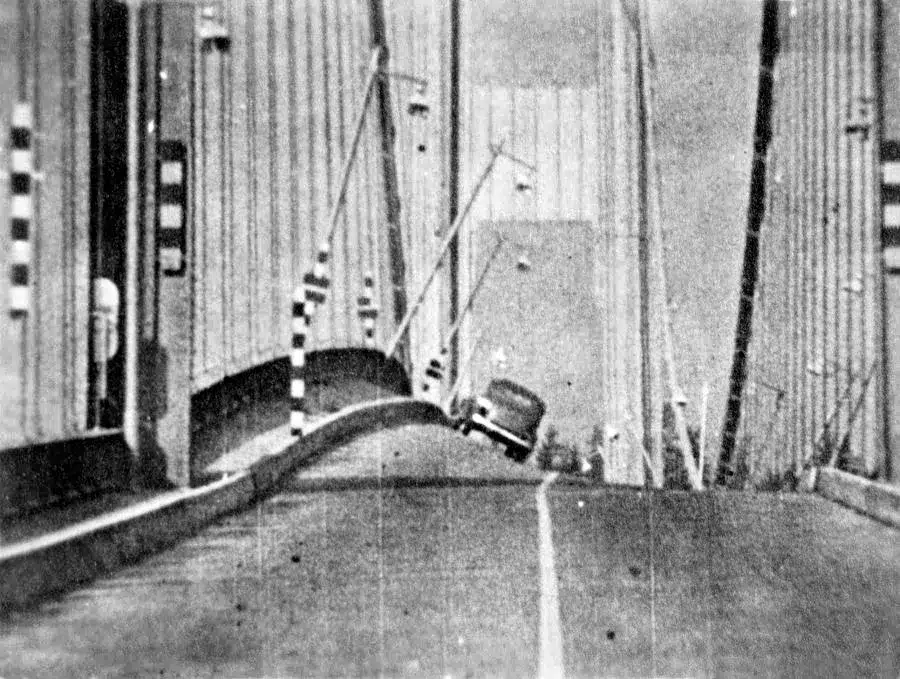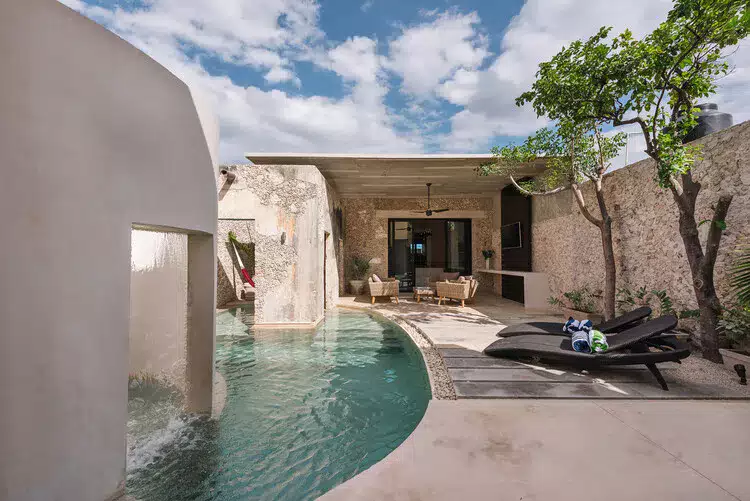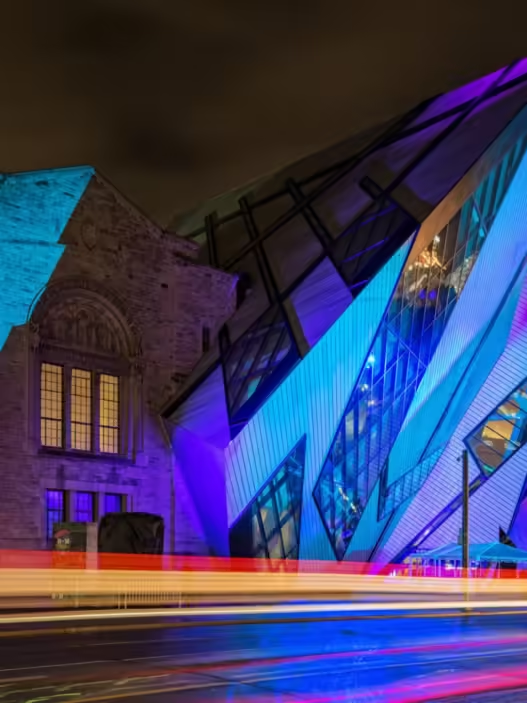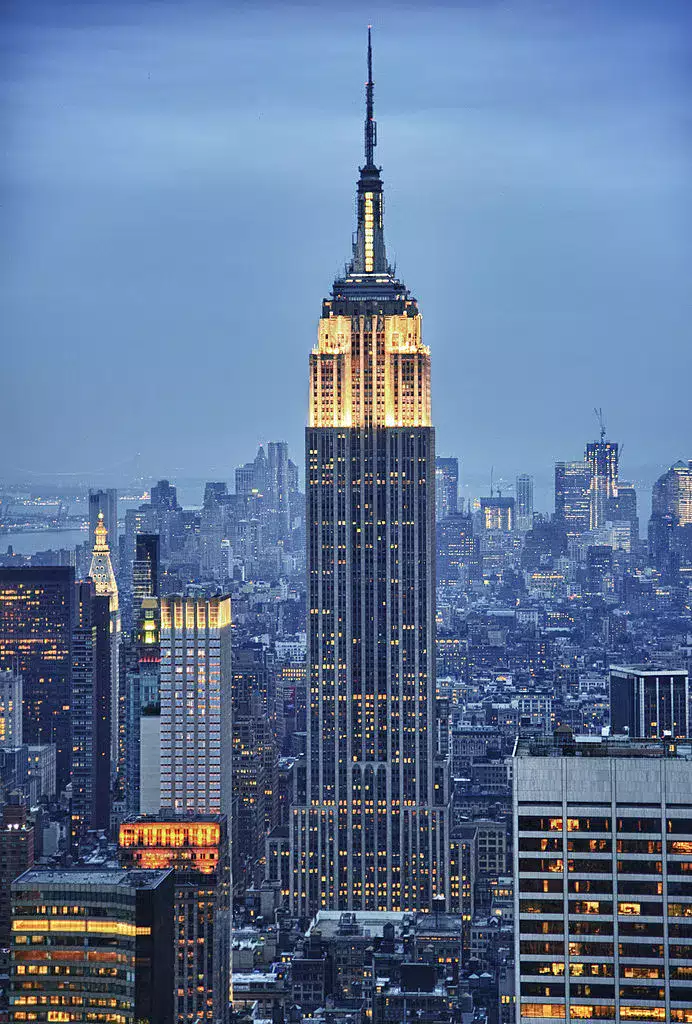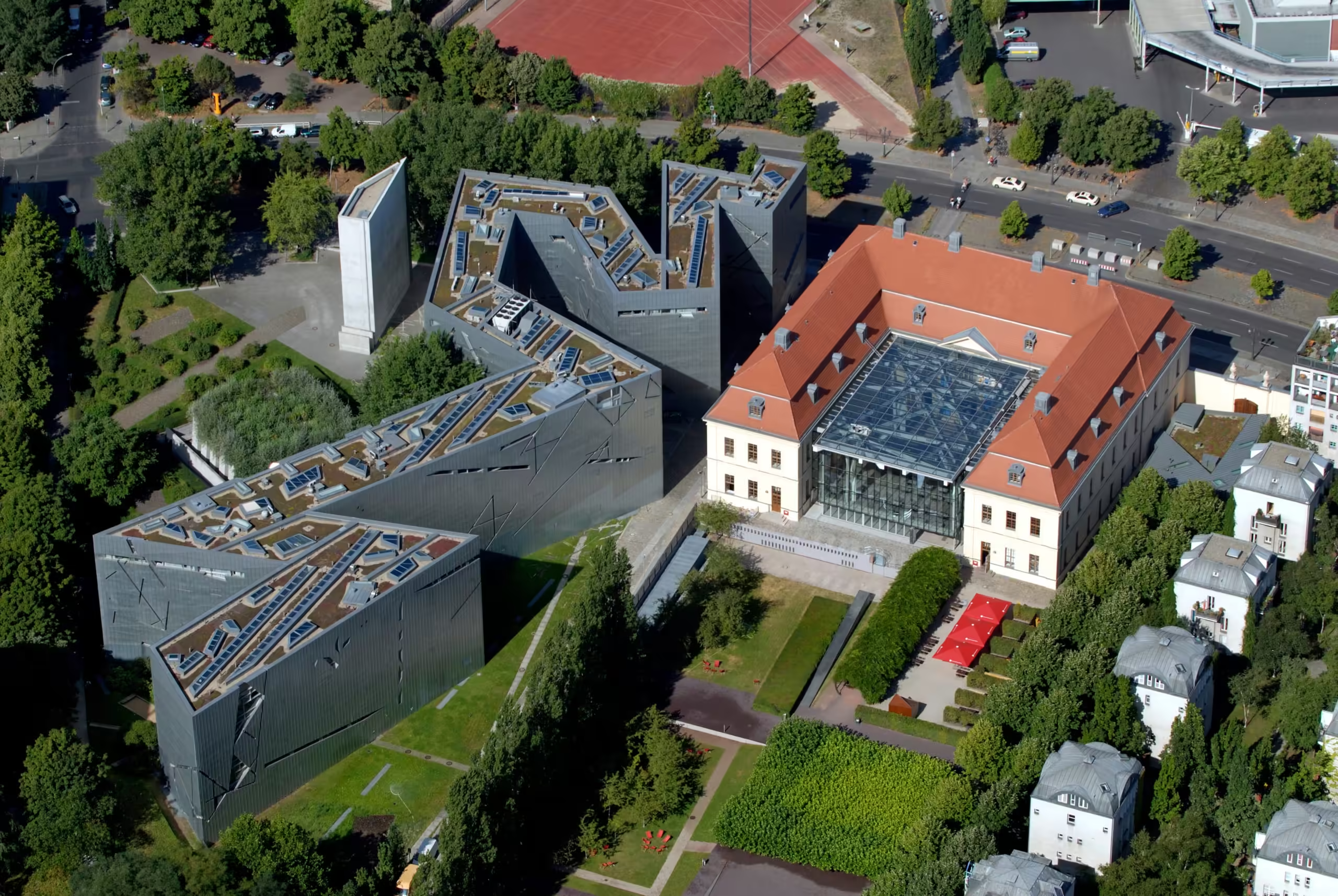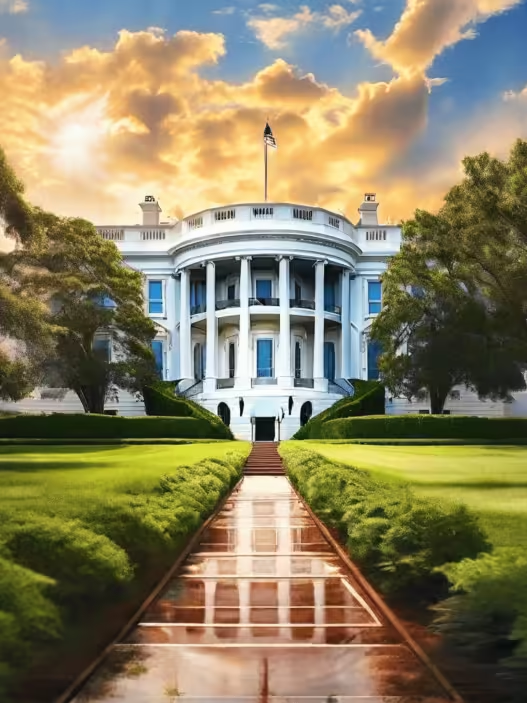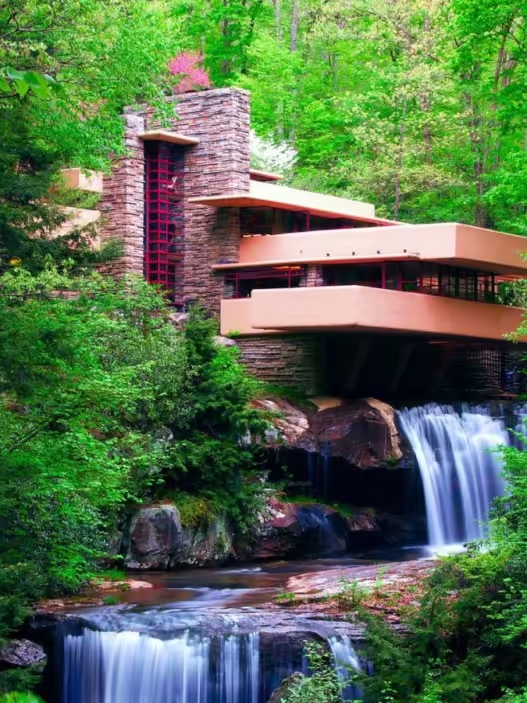When architecture is used to commemorate tragedy, light often becomes the most meaningful material. Light can imprison the mourners’ experiences in darkness or release them with a glow; it can mark the exact moment of loss or gently blur the passage of time; it can create silent shelters or bring communities together for collective remembrance. With thoughtful choreography, light carries grief—guiding us from shock to understanding—but it should not do so in a showy manner. In monuments around the world, architects and designers are learning to balance brightness and shadow, ritual and responsibility, to ensure that lighting serves healing.
1. The Choreography of Darkness and Light: From Shock to Understanding, Without Performance
How should architects use darkness and light in a choreographed way to guide those mourning from shock to understanding – without being flashy? Monuments usually take visitors on a journey from darkness and confined spaces (reflecting shock and despair) to gradually revealing daylight and openness (encouraging reflection and acceptance) a light-filled journey from confinement to liberation. The challenge here is to do this in a powerful yet subtle way, avoiding any theatrical spectacle that might trivialize the pain.
Designers conduct a careful daylight analysis to set up this process. Climate-based metrics such as Spatial Daylight Autonomy (sDA) and Annual Solar Exposure (ASE) ensure that spaces receive sufficient natural light without glare. For example, LEED recommends that at least 55% of occupied spaces meet the sDA300,50% value (i.e., receive 300 lux of daylight for at least 50% of the year) and that no more than 10% of spaces exceed the ASE1000,250 value (over 1000 lux for 250 hours, which creates a glare risk). By using these threshold values, architects can provide sufficient daylight to create a comfortable lighting environment in memorial halls while limiting areas exposed to harsh direct sunlight that could create a “glaring” or overwhelming sensation. Daylight Factor (DF) is often checked in early mass studies, for example, by targeting 2-5% DF in thinking areas for a subdued ambient light, before more dynamic climate simulations are performed. Daylight Glare Potential (DGP) is also evaluated at critical moments (e.g., when a mourner first enters a dark room or steps into the light) to keep glare below uncomfortable levels. (DGP values below 0.35 are generally considered imperceptible.) Practically, this means that direct sunlight should not reach eye level in the transition areas of the monument when visitors are present, as even a single bright ray can disrupt the contemplative state. Instead, light enters indirectly, reflected off walls or filtered through openings, providing a “dim but clear” view.
One strategy is to create “light valves”: thin roof windows, slits, or partitions that allow only a limited amount of sunlight to pass through, and only at desired angles or times. Annual solar path studies can test how these slits perform throughout the year and, by ensuring that a beam of light falls on a wall at a specific date or grows slowly as the day progresses, can metaphorically rescue visitors from darkness. For example, at the Canadian National Holocaust Memorial in Ottawa, architect Daniel Libeskind designed an open-air arrangement of angled concrete volumes (shaped like a broken Star of David) that create a series of light and shadow “rooms” that interconnect. Visitors enter a narrow, canyon-like space largely shrouded in shadow, between steeply sloped walls. As they move toward the central plaza, the space widens and the sky opens up. Sloping concrete planes capture light differently throughout the day—one illuminated by sunlight, the other remaining dark, amplifying the sense of disorientation that reflects the historical horror. However, upon reaching the square, a brighter opening comes into view. Here, the 14-meter-high “Sky Void,” with an endless flame burning inside, frames the sky above and creates a sharp opening of light in an otherwise enclosed space. Even this void is meticulously illuminated: daylight enters from above, tracing the sloping walls without ever creating excessive brightness. Visitors’ eyes adjust from the previous dim corridors, so the light of the void toward the sky creates a sense of gentle elevation, not an overwhelming flood of light. Lighting designer Focus Lighting won the Lumen Award for achieving this delicate balance. Glare has been prevented; the flame and ceiling window provide a focal point of light without exposing visitors’ eyes to direct sunlight. By quantifying measurements, the team ensured that the DGP remains low (below the “disturbing” range) even at midday and that surfaces maintain moderate brightness levels to preserve a calm atmosphere.

The National Holocaust Memorial in Ottawa uses six sloping concrete volumes to create a star-shaped labyrinth. When you walk through it, the narrow passages are in shadow, while certain planes catch the low-angle sunlight and guide visitors from darkness toward a central space that is open and brighter.
This project exemplifies how controlled light can guide mourners from shock to understanding. The initial darkness and confinement (both spatial and in terms of light) evoke the weight of history; as Libeskind noted, even if you don’t know the story behind the memorial, you find yourself in a space that conveys a certain spirit. This spirit is felt through the chiaroscuro effect of geometry and light. The monument “releases” you slowly into the wider daylight and view—in fact, when you emerge from a long staircase, visitors see the Peace Tower of the Canadian Parliament, a symbol of hope, beyond the walls of the monument. The absence of eye-catching elements is crucial: there are no colored lights or dramatic projectors, only natural light and measured accent lighting at night. This restraint aligns with the philosophy of academic Kaoru Mende, who believes that architectural lighting for monuments is “not about making a grand statement, but about expressing emotions.” In Ottawa, feelings of loss, contemplation, and morale are expressed not through flashy technology but through the amount and angle of the sunlight encountered.
Another instructive example is the Hiroshima Peace Memorial Park designed by Kenzo Tange. More of an open landscape than a building, this structure uses alignment and light masterfully to take visitors from horror to hope without resorting to any tricks. The focal point of the park is a concrete arch in the shape of a saddle, under which the “Peace Flame” burns. Through this arch, the remains of the Atomic Bomb Dome can be seen beyond a tranquil pond. This straight axis (museum → memorial tomb → flame → dome) was deliberately designed: Tange aligned these elements so that those standing in front of the memorial tomb could literally see the light (the flame) in front of the darkest symbol (the dome). The arch itself provides a dim, sheltered space for reflection; when you enter the arch, the noise of the city is cut off, and the structure frames the sky, closing off the landscape. In the architect’s plan, this is defined as an “invisible axis” that creates monumentality not through large objects, but by directing sightlines and sunlight along the peace oath. The glow of the flame, especially at dusk or dawn, is like a gentle beacon: its design (a sculpture of hands holding the fire) symbolizes the thirst of the victims and the prayer for the elimination of nuclear weapons. There is no theatrical element in this arrangement—only natural light and a single flame—yet its impact is profound. As one observer noted, when you look through the arch, you see the flame and the dome perfectly aligned; the light itself becomes a promise stretching from tragedy to hope. Even the timing has been considered: every year on August 6 at 8:15 a.m., the moment the bombing took place, the sun park is bathed in soft morning light for the peace ceremony, reinforcing the sense of renewal. Hiroshima’s design teaches that the choreography of light can be as simple as creating axes and thresholds that transform the viewer’s visual experience from darkness to light. The monument, which achieves this with humble elements such as sunlight, fire, and concrete, moves away from ostentation to create a sacred atmosphere.
Technically, architects confirm that Hiroshima’s memorial square receives sufficient daylight for meetings (using DF or sDA to ensure that it receives mostly sunlight, as it is an outdoor space) and that the interior of the arch remains in soothing shade. They also prevent those approaching the flame from being dazzled: indeed, the base of the flame is designed to be visible even in direct sunlight but not so bright as to cause glare. As in many contemporary monuments, such as those in Hiroshima and Ottawa, the ethical principle is clear: allow the light to emerge slowly. Greet visitors in an intimate twilight, allow their eyes and hearts to adjust, then guide them toward a bright opening or guiding light that symbolizes meaning or the future. To fine-tune this journey, computational daylight models, physical mock-ups (tested under various sun angles), and glass selections (e.g., diffused glass in skylights) are used in the background. When done correctly, the result is not a “light show,” but rather a natural and transcendent experience where darkness and light blend together in a measured rhythm, as if the space itself were gently breathing.
2. Astronomical Alignment: Making Memories Feel Like They Happened Just Moments Ago
Can astronomical alignment make memories feel as if they are happening right now? Some monuments use the cosmos as a design element and align themselves with the sun or stars to ensure that a beam of light or shadow falls exactly at a specific date and time (usually an anniversary or symbolic moment). These time-dependent light events ritualize memories in a way no static monument can, poignantly reminding us that something happened at this very minute, on this very day. This is a way of anchoring memories not just to a place, but also to a time.
Achieving such precision requires combining an ancient craft like archaeoastronomy with modern tools. Designers must calculate the azimuth and altitude values of the sun for the target moment (taking into account time equations that account for small changes from year to year, as well as latitude, longitude, and other factors). Using solar geometry software or astronomy formulas, it is possible to predict exactly where the sun’s rays will fall at a specific time, such as 11:00 a.m. on November 11 (a date with symbolic significance). Tolerances must be considered: Will the effect be useful every year, including leap years? What about atmospheric refraction or daylight saving time when the sun is low on the horizon? Generally, some flexibility (e.g., a few minutes’ time window) is allowed, or the event is specified in standard time to avoid daylight saving time issues. Monitoring the data can assist with post-construction improvements: for example, checking whether the beam arrives slightly early/late and adjusting the shutters if possible.
A famous example is the Armed Forces Memorial in Staffordshire, England. This massive circular monument, located in the National Memorial Arboretum, was built to honor British soldiers and features a slit in its southern wall designed so that on November 11 at 11 a.m. (Armistice Day), sunlight passes through the slit and illuminates the bronze wreath at the center. On November 11 at 11:00 a.m., if the weather is sunny, a beam of light slowly moves forward and pauses briefly over the wreath. Thus, the site of the monument merges with the moment in 1918 when the guns of World War I fell silent. The effect is striking: Hundreds of people gather in silence, and for one minute, the golden sunlight connects the past with the present. The records of the Imperial War Museums describe it as follows: “A gap in the two southern walls… so that at 11 a.m. on November 11, the sunlight falls directly onto the bronze laurel wreath on the base.” The architects (Liam O’Connor and his team) must have calculated the angle of the sun for that date (in central England, the sun is quite low in November). To accurately calculate the geometry of the mound and walls, they likely constructed the entire structure at this angle. This precision was confirmed after construction—it does indeed work, though heavy clouds can obstruct it (a reminder that nature has the final say!). The power of this astronomical alignment lies in how concrete it makes the act of commemoration: the crowd can literally see time manifesting itself as light. In those moments, the memory is not abstract – it is happening right now, like a living beam connecting those present with those who are not there.
Other monuments are exploring similar arrangements. Designers are asking: Are there local tragedies or heroes whose memory could be honored during a specific celestial event? For example, in the United States, a monument could be imagined that aligns with the sun’s position in New York at 8:46 a.m. on September 11 (the time the first tower was struck), creating an illuminating light or shadow. In fact, the old World Trade Center “Memorial of Light” (two vertical beams erected every September 11) does this indirectly: it lights up every day at sunset on September 11 and fades at dawn. However, we will address this topic later. Another example is the Anthem Veterans Memorial in Arizona. This monument is often compared to a modern Stonehenge: Every Veterans Day (November 11) at 11:11 a.m. local time, the sun aligns with five marble columns representing the Armed Forces, reflecting sunlight onto the Great Seal of the United States. The design goal was so precise—11:11:11—that engineers accounted for even minor annual changes: over the course of a century, orbital mechanics could cause the exact alignment to vary between 11:10:58 and 11:11:22. They even note that if conditions change over the years, this effect could be visible on the 10th or 12th. This meticulous planning, confirmed by analysis and even published in technical reports, demonstrates how seriously the designers took the choreography of the sun and shadow. A PDF file obtained from the community council explains that celestial models were used to position the columns and elliptical openings at the correct angles. The result has drawn national attention—every year, crowds gather at Anthem to watch the sun’s one-minute salute.
Consider how such an approach might work in other contexts: in Japan or Korea, monuments could be aligned to the exact time when an earthquake struck or a ferry set out on its ill-fated voyage. Imagine a 2011 Tōhoku earthquake memorial in a dark room, with a beam of light shining at 2:46 p.m. on March 11th each year (the exact moment the earthquake struck). The light might refract through a crystal, spreading like a soft aurora—a symbol of the countless souls who lost their lives in an instant. Or, in a memorial for the 2014 Sewol ferry disaster in South Korea, it could be a glass eyehole in the sun at the time the ship sank, reflecting a moving circle of light slowly sinking onto a wall with names written on it—a touching reenactment made with light, almost literally. Though hypothetical, these ideas are based on real methods used elsewhere. The key is meticulous sun study: using ephemeris data and even physical models to ensure alignment. Tolerance analysis is important; for example, the Anthem Memorial team allowed for a ±24-second deviation over 100 years and set the target without needing annual adjustments. They also had to take into account that the apparent diameter of the sun (~0.5°) is quite small, so openings or gaps typically needed to be slightly larger than a pinhole to achieve a full beam of light. If atmospheric refraction is significant (e.g., near the horizon), the designer can adjust the angle slightly downward, knowing that refraction will cause the sun to appear a few minutes earlier. These are fine details, but they can make the difference between success and failure.
Such alignments offer mourners an event to anticipate and participate in, linking memories to natural cycles. They ritualize remembrance: people gather to watch the sun or stars perform their duties, as if the universe itself were commemorating the loss. At the British Armed Forces Memorial, participants fall silent at 11:00 a.m. when the light appears; this is a secular but semi-spiritual two-minute “sun silence.” Similarly, suggestions have been made to align memorials with local sunset times. For example, a concept for the September 11 memorial proposed that every September 11 evening, the setting sun would align with the street grid (like a planned “Manhattanhenge”) and illuminate the memorial site, blending the city’s daily rhythm with the memory of the tragedy. This idea was not implemented in the physical WTC memorial, but it reflects the concept of linking cosmic time with human loss.
Care should be taken from a design ethics perspective: these effects should not become a gimmick. If taken to extremes or marketed as a tourist attraction, there is a risk of undermining seriousness (no pun intended). However, when used in a measured and clear-cut manner, they can have a profound impact on people. Here, success criteria are not just lumen levels, but emotional impact and engagement. Technically speaking, we can ensure that the light beam provides sufficient illumination at the target point (e.g., at least 3000 lux on the facade to be visible in daylight). Software (such as Grasshopper or even simple SunCalc) can simulate the sun’s movement with an accuracy of one-tenth of a degree. Since weather conditions can be an obstacle, designers often create a secondary commemoration strategy in case nature does not cooperate: for example, the Armed Forces Memorial Ceremony continues with readings and a moment of silence even on cloudy Armistice Days. – symbolism, even if it cannot be observed in the literal sense, continues to exist in the collective memory.
Astronomical alignment makes memories tangible by linking them to the actual movements of the Earth and the Sun. Architecture and astronomy go hand in hand. These designs remind us of the passage of time, as if time itself had been frozen or frozen in time, when the precise alignment occurs again, even years later. For mourners and the public, this experience can be deeply healing—an annual celestial rendezvous for honoring and reflecting. This is the opposite of forgetting; it is, quite literally, remembering with the stars.
3. Water, Reflection, Fog, and Night: Transforming Absence into Illuminated Presence
How do water, reflection, fog, and night transform light from nothingness into existence? In monument design, reflective surfaces—pools of water, mirrors, polished stones, or even fog in the air—play a magical role: they double and scatter light, creating an ethereal glow that often makes the presence of what is absent (or the absent person) felt. Especially at night, these elements softly illuminate the void, allowing mourners to see without being dazzled, and feel as if spirits or memories have taken over the space, gently bringing it to life. During the day, reflections add movement (rippling water reflections) to static monuments, slowing down time and encouraging contemplation. Essentially, water and mist bend light into shapes that solid architecture cannot achieve, creating an atmosphere where joy and sorrow share the same ground—the brightness of candles or beams coexists with the dark void of loss.
Designers use luminance mapping to study how light interacts with reflective surfaces. For example, a calm pool can be seen as a horizontal mirror: in calculations, the reflection ratio can be high at shallow angles. It is possible to simulate a night scene to ensure that illuminated objects (such as lighted chairs or candles) are clearly reflected in the water without excessive distortion. Glare control is very important – reflections should not create bright spots that dazzle visitors, but rather create a soft glow. This usually involves identifying low-wattage or diffused light sources around the water and ensuring that the reflected brightness is below 500 cd/m² at eye level to prevent discomfort. Nighttime lighting levels are also adjusted: monuments are generally illuminated very softly (1–10 lux in general areas, sufficient for safe movement, with slightly higher levels at focal points such as names or sculptures). Luminaires are covered with protective covers or directed downward (cut-off angles) so that the light source is not seen directly, but by reflection. In humid or foggy climates, designers even consider how light beams will appear in fog. Humid air can beautifully highlight light beams, but too much brightness can be blinding. Therefore, by testing a foggy night scenario, designers can ensure that the monument does not appear harsh when fog settles; instead, the fog can simply capture the light around certain features, such as a soft glow around water or a sculpture.
A powerful example of these ideas is the Oklahoma City National Memorial in the United States, located at the site of the 1995 bombing of a federal building. The design includes the Empty Seats Area, featuring 168 bronze and glass chairs (one for each life lost), and a long, shallow Reflection Pool where the bomb exploded. During the day, the surface of the pool reflects the open sky and surrounding trees, creating a sense of peace and continuity. The designers aimed for the pool to appear “motionless,” symbolizing the calm that followed the chaos. At night, the monument truly comes to life with soft lighting: each chair has a glass base that glows from within after darkness falls, shining like lanterns with the names of the victims engraved on them. With this effect, the chairs transform into “168 beacons of hope” in the darkness. Visitors see the warm light reflected in the black pool, and the space is doubled—literally, light where there is nothing. The interior lighting is low and even, so the names can be read without glare on the glass. According to the National Park Service, the chairs’ lights are controlled by photocells and automatically turn on at dusk and off at dawn. The lighting level has been carefully selected: bright enough for each name to be read (a few lux on the glass surface with sandblasted letters for contrast), but not so bright as to be blinding or obstruct the night vision of visitors walking between them. Urban Land Magazine summarized the monument’s theme as “A Dark Day. Bright Years,” noting that the city remembers April 19, 1995, as a dark moment but has found hope since then. At the monument, this metaphor comes to life every night: darkness falls, and then these chairs gently light up one by one for each person who is missed. The reflective pool captures every light and reflects it onto the water. Those who mourn often say they feel the presence of spirits in these reflections—it is an illusion, but a comforting one.
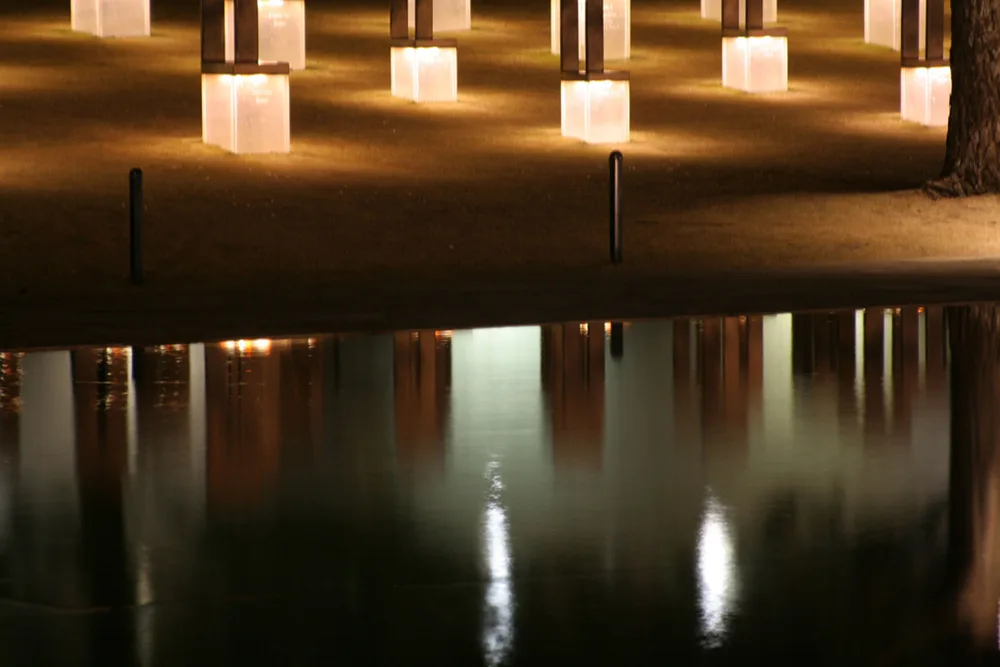
At the Oklahoma City National Memorial, each victim is symbolized by an empty chair with a shiny glass base reflected on the calm surface of a reflective pool. Soft lighting transforms the emptiness into a gentle presence every night, making the absence tangible.
The monument’s designers (Butzer Design Partnership) had to solve technical problems to achieve this tranquility. Working with engineers at MIT, they tested the glass for the chairs and ensured that it would not crack under thermal stress in Oklahoma’s hot days and cold water or rain. The glass bases were designed as open, hollow blocks, with low-voltage bulbs or LEDs made of frosted glass inside to evenly distribute light. The brightness of each base is sufficient to read the names in the dark, but due to the dark background of grass and sky, there is very little contrast glare. In fact, when walking through the area at night, a constellation of softly glowing rectangles can be seen—a elegant solution that enhances visibility and symbolizes individual spirits. Meanwhile, the Reflection Pool was designed by Delta Fountains to remain exceptionally smooth (they designed a hidden basin and a careful circulation system to allow 8,500 gallons of water to circulate per minute without ripples). This allows for clear reflections of the chairs and the Time Gate (two monumental walls inscribed with “9:01” and “9:03” at either end, framing the time of the explosion at 9:02). The gates are subtly illuminated at night, making the inscriptions visible yet not blinding. According to the NPS, the doors and chairs are automatically illuminated at night. The result is a monument that evokes an almost sacred feeling at night: silent, with only a few whispers or footsteps, perhaps the faint sound of a waterfall at the edges of the pool (used to circulate the water). In this environment, the light reflecting off the water seems to slow down time. People often linger between the chairs to see their own reflections—as the monument’s text states, “The calm surface creates the reflection of someone who, with their visit, changes it forever.” Indeed, when you stand at the edge of the pool, you see yourself and the chairs reflected together, inviting you into a space of memories.
Another example of light filling the void is the annual Tribute in Light event held in New York City. Every year on September 11, two powerful vertical beams of light, created by 88 xenon projectors, extend up to four miles high, roughly following the path of the Twin Towers. This is not a permanent monument (the official 9/11 Memorial consists of two reflective pools located where the towers once stood), but it has become a ritual installation. Every September 11th night, from sunset to dawn, these twin columns of light pierce the darkness and can be seen from 60 miles away. These lights literally transform absence into light—the lost (the towers and the lives within them) are commemorated through beams of light that are felt but have no tangible form. The emotional impact is immense: many people describe feeling both grief and a strange sense of elation when they see the Light Monument, as if spirits were rising upward. Technically, to make absence visible, designers had to create an extremely intense light (each beam is 7,000 watts, with 48 lamps per square meter). The normally dark night sky becomes a canvas; in humid or foggy weather, the beams become even more distinct and glow as they intersect with particles in the air. Interestingly, this installation also highlights the interaction with wildlife and the environment: the beams attract migrating birds (tens of thousands of birds can be seen circling in the columns of light), which has led to the creation of protocols for periodically turning off the beams (this will be discussed in more detail in the next section). In a poetic sense, the rotation of birds or butterflies in Tribute in Light adds a natural, almost ghostly movement—the small tremors within the beams remind viewers how alive and dynamic even a monument can be.
Tribute in Light is a gesture that commemorates the power of light against the night sky. It contrasts with the reflection of water: here, people look up at the sky instead of down at the pool. In both cases, the effect relies on the interaction of light with an environment (water in one case, air (and moisture/dust) in the other) to create a sense of volume and presence. On a clear, dry night, the light from a simple projector is almost invisible except where it hits the clouds. However, in New York’s hazy atmosphere, the path of the Tribute is clearly visible. Similarly, a single light fixture standing alone at Ground Zero may appear ordinary in the literal sense, but its reflection and dispersion give it a sorrowful quality.
Monument designers often use water elements because of their reflective properties and symbolism (water, purification, life, or tears). The Vietnam Veterans Memorial in Washington, D.C., famous for its reflective black granite walls, was originally completed with nearby fountains; the combination of reflective stone (which reflects visitors’ faces onto the carved names) and the sound and sparkle of water creates a multi-layered sensory experience. In more recent designs, mist fountains that capture light have been proposed. For example, in a monument, a single beam of sunlight in a dark room combined with fine mist can create a glowing curtain in the air (similar to the visible rays of sunlight passing through incense in a church). This interaction between mist and light can evoke a sense of fragility and transience that is appropriate for monuments. However, architects must be careful to balance humidity and maintenance (excessive mist can make the floor slippery or obstruct visibility too much). Generally, intermittent fog is used during ceremonies or at specific times to avoid continuously humid conditions. When used, lighting is typically directed behind the fog rather than using front lighting that would dazzle the audience and flatten the image.
In all these cases, brightness mapping and models guide the design. For Oklahoma City, before finalizing the bulb density, they illuminated a sample chair at night to check the readability of the name and how its reflection appeared on the water. For Tribute in Light, after the first exhibition in 2002, extensive tests were conducted to measure how far the display could be seen and how wildlife reacted, in order to optimize the brightness and program. In reflective pools, it should be noted that sunlight can reflect off the water during the day and sometimes cause glare. In Oklahoma, the pool is north-south oriented and narrow, so midday sunlight reflects upward (not toward the main viewing angles), and the sloped edges of the pool help block low-angle sunlight reflections. In the morning and evening, the sun’s low rays can create a reflection of the sky in the pool without glare for visitors, as the geometry of the surrounding plaza blocks direct reflection angles. These subtle geometric changes are typically the result of careful consideration of the sun’s position; for example, ensuring that the sun does not reflect onto the face of a person standing at the edge of the monument at 5:00 PM. If such a situation arises, the designer could add a slight ripple or diffusion texture to the water surface or strategically place a tree or sculpture to provide shade.
Water, reflection, fog, and night allow light to “speak” in soft tones. They transform sharp light into a glimmer, a sparkle, a dance of reflections, inviting social awakening. When those in mourning gather here in the evenings, the reflections show that every candle, every chair, every light is doubled. The community sees the light. In this act, joy and sorrow come together: there is sorrow because these lights represent loss, but there is joy (or at least consolation) because we can still see them and come together in their glow. The silence of the night and the softness of the reflected light create a protective environment for memories, which can be called “luminous silence”. In this dim, bright silence, people experience moments of deep connection with both the deceased and with each other.
4. The Sound of Silence: Adjusting Acoustic-Light Harmony in Monuments
What are the best acoustic-light ratios for maintaining silence, and when should a space allow sound? Monuments are visual and spatial experiences, but they are also sound environments. Mourning is often accompanied by moments of silent reflection as well as the expression of emotions (crying, praying, singing). Therefore, architects must balance the acoustics and lighting of memorial spaces, preserving silence when necessary and allowing sounds to be heard at the right moments—whether it be the reading of a single name or a collective hymn. Light and sound interact through subtle psychological pathways: a very bright space may encourage people to talk or break the silence, while dim, dappled light can naturally trigger whispers. Conversely, a completely dark space where even faint sounds can be heard can feel frightening or uncomfortable. For this reason, designers aim to achieve an acoustic-light balance, known as “light reflection.”
Quantitatively, acousticians use Reverberation Time (RT60) as a basic criterion: the time (in seconds) it takes for sound to decrease by 60 decibels in a space. Monument design may aim for different RT60 values in different areas. For an intimate chapel-like room where the names of victims are displayed (or individuals can silently mourn and pray), a short RT60 (approximately 0.5–1.0 seconds) is desirable; this means that sounds (coughing, footsteps) quickly fade away, preserving the overall silence. Hard concrete or stone surfaces commonly used in monuments can cause long reverberations (easily 2–3 seconds), so acoustic absorption must be carefully provided in such spaces (felt linings, micro-perforated panels, or softer materials such as wood or fabric in some areas). Conversely, in ceremonial halls or open-air squares where people gather annually to speak or sing, a slightly longer RT (approximately 1.5–2.0 seconds in outdoor spaces, slightly shorter indoors if speech clarity is required) sonorous quality – a slight reverberation that makes sounds more audible and important (think of how the 2–3-second reverberation of a cathedral lends solemnity to songs). However, even in these cases, excessive reverberation is detrimental to speech intelligibility, so designers find an appropriate middle ground. ISO 3382 (the standard for measuring reverberation) is used in design simulations to ensure compatibility. For example, in a monument’s “Hall of Sounds” (if it is intended for ceremonies), a mid-frequency RT60 of approximately 1.2 seconds may be targeted. Research shows that this value ensures that speech is clear to listeners while adding a slight sense of reverence to the sound. On the other hand, in a quiet corner or “weeping room,” the RT60 may be 0.6 seconds to prevent noticeable reverberation, similar to the standard for a small conference room or library. These targets can be achieved through material selection and geometry. Absorbent coatings, such as fabric-covered panels or foam, can be integrated into the back of perforated artworks or into benches. It is noteworthy that many monument designers conceal acoustic treatments to achieve a serious aesthetic appearance; for example, a cassette ceiling can also function as a sound trap, or the sound of a water feature can mask unwanted noise.
So how does light get in? Where light is strongest, sound is usually strongest too – think of an open, sunny courtyard, which is typically empty and echoey. In contrast, a dim corner may be enclosed and quieter. Designers often coordinate light intensity with acoustic absorption: if bright sunlight illuminates a wall, that wall can be covered with rough stone or have angled surfaces to diffuse sound (to prevent flutter echoes). If an area is brightly lit to encourage gathering and conversation (e.g., a monument visitor center or exhibition hall), the acoustics may be more lively; but if it is brightly lit yet intended to be quiet (this can create a situation described by an acoustic expert as “fragile silence,” where even the slightest sound becomes distracting in a bright space), this is a problem. The term “excessively bright, ‘fragile’ silence” describes this situation very well: too much light and too little background noise or echo can make visitors feel self-conscious. For example, a white, sunlit room that is supposed to be quiet can be disturbing because footsteps echo loudly. To prevent this, designers can add a soft ambient sound (such as the sound of distant water) or soften surfaces to prevent footsteps from echoing. Reducing lighting can also psychologically cause people to lower their voices. It is no coincidence that memorial spaces that encourage silence (such as the Hall of Remembrance at Yad Vashem or the quiet areas of the 9/11 Memorial Museum) are typically dimly lit, with light directed only at focal points (names, exhibits) – this low lighting naturally encourages people to speak in hushed tones. In contrast, areas intended for discussion or education are well-lit.
Let’s revisit two previous case studies related to acoustics: the Ottawa Holocaust Memorial and Hiroshima Peace Park. The Ottawa memorial consists of open-air concrete “rooms.” Concrete is highly reflective acoustically, and sharp angles can create echoes. However, the geometry of the design—sloped, non-parallel walls—helps break up sound reflections (preventing the “ping-pong” echo of parallel panels). The courtyards are also partially open to the sky, which allows sound to disperse upward. The largest central square used for meetings likely has a longer reverberation time compared to smaller niches. When measured, the central area’s RT60 value may be approximately 1.5 seconds (outdoors but surrounded by walls), while narrow corridors may feel almost echo-free due to sound escaping. During a ceremony (e.g., a Holocaust remembrance event), sound must be audible in this area. A sound system can be used, but even without one, the slight reverberation adds a sense of solemnity. On a normal day with few visitors, the acoustic properties, combined with changing light and shadows, create an eerie silence. Responsible partner Carla Swickerath noted that the concrete surfaces preserve their “imperfections.” Interestingly, the rough concrete texture can absorb slightly more sound at high frequencies compared to perfectly smooth surfaces, so the choice of finish (in addition to its aesthetic qualities) provides a small acoustic benefit. Those looking to fine-tune Ottawa’s acoustics may consider adding absorbent material to invisible areas—such as the undersides of benches or the interior of the room housing the “Memorial Fire.” Focus Lighting’s lighting design appears to carefully consider glare and shadow to ensure that illuminated areas (such as the area around the fire) do not cause visitors to squint or raise their voices. This interaction is very subtle: both dim and echoey spaces can feel oppressive, so if a space is very quiet (low RT60), it may be acceptable to allow it to be darker in keeping with the environment. The monument in Ottawa achieves a balance between open-air silence (silent but natural, as there is no roof to trap sound) and a mix of light (some areas are bright, others have deep shadows). This encourages visitors to be psychologically mindful and respectful of movement and sound.
The Hiroshima Memorial Park is an open-air site, and although some city noise can be heard, it is generally a quiet park. Every year on August 6, thousands of people gather early in the morning for the peace ceremony; at 8:15 a.m., a bell rings and a minute of silence is observed. Acoustically, the park is sufficiently open to avoid echo issues; however, external noise (traffic, etc.) may pose a challenge. The monument, designed by Tange with its trees and distance from the city center, helps reduce noise to some extent. A sound system is used when speeches are permitted (e.g., speeches by officials), but the natural acoustics are soft. The arch of the memorial tomb is a concrete half-shell; it is possible to wonder whether this arch focuses (like a concert stage) or reflects sound. Its shape could theoretically focus sound waves to a point; however, since it is relatively low and open, this is likely imperceptible. If you stand underneath and speak, some reflection may be heard, but because it is open air, it is not like a whispering gallery. The choice to keep much of the park acoustically unrestricted allows wind, water, and perhaps bird sounds to be heard during quiet moments—a pleasant, unobtrusive soundscape. When sound is heard (prayers, choir songs), the openness allows the sound to spread without harsh reflections. Here, the acoustic design was landscape-oriented—memorial elements were arranged sufficiently far apart and separated by vegetation or water to prevent unwanted echoes or amplification of sound.
In indoor memorial spaces (such as museums or galleries established to commemorate tragic events), designers often combine controlled lighting with acoustic absorption to create an atmosphere conducive to reflection. For example, the Srebrenica Genocide Memorial Room in Sarajevo is dimly lit with spotlights on personal belongings and names; the walls and ceiling are designed to reduce echoes, creating an environment as quiet as a library. If this room had been lit with fluorescent lights, its sanctity would have been diminished and people would have been able to speak louder. There is a scientific explanation for this: studies show that people speak more softly in dim light. This is a phenomenon related to self-awareness or mood. Additionally, people also speak more softly in environments with lower background noise (if a space is very quiet, people often instinctively whisper to avoid “breaking” the silence). Monument designers take advantage of this “library effect.” However, the silence should not become uncomfortable. One technique is to use a very low level of background noise (such as HVAC noise or distant music) to prevent complete silence, as complete silence can amplify the sound of a person’s breathing or stomach rumbling, which can be distracting. In acoustic terms, a low background noise level (perhaps NC-20 or 25, very quiet, ~20 dB(A)) is ideal. The WELL building standard for Mind & Comfort may not be directly applicable, but it conveys the same idea: keep mechanical noise low to enable quiet thinking.
When should an area allow sound to be heard? Monuments often have areas designated for sharing stories or holding ceremonies. These areas can be acoustically adjusted for speech or music. For example, in a monument amphitheater, a slight echo may be intentionally created to achieve a grand sound (the podium at Gettysburg National Cemetery has a natural amphitheater feature). In indoor spaces, such as the “Testimony Hall” of a genocide memorial, the acoustics may be lively enough for a survivor speaking to a tour group to be heard clearly without a microphone. This could mean an STI (Speech Transmission Index) value of ≥0.6 (very good) and an RT value of approximately 1.0 seconds. If the same room is used annually for reading names, some reverberations may enhance the human voice during the reading and impart a solemn rhythm.
To make these decisions, acoustic consultants can create 3D models of the monument and run simulations (using ODEON or EASE software) to estimate RT, clarity (C50/C80), and STI values in important areas. They then repeat the measurements or add absorbers until the target values are achieved. Lighting consultants simultaneously develop the lighting plan; for example, they coordinate where to place acoustic panels so that they are not visibly illuminated by accent lights (i.e., do not catch the eye) or, conversely, how to use light to divert attention away from acoustic features. Results are measured after construction; for example, an impact response test (balloon pop or dodecahedron speaker) can be performed on the finished monument to verify RT60. If an area is too reverberant, more absorptive material can be added quietly (e.g., adding carpet or curtains under benches). If it is too dead (rare in monuments but possible if excessively carpeted), some panels can be removed or even a subtle soundscape added (e.g., very low-level water or wind sounds to evoke a sense of life).
One special consideration is to prevent noise from entering the interior – since many monuments are located in city centers, designers use thick walls or traffic noise insulation to ensure that the interior remains suitably quiet. For example, the 9/11 Memorial Museum, despite being located in bustling Manhattan, uses its underground location and heavy structure to create an isolated environment where only the sound of waterfalls from the memorial pools above can be heard. These waterfalls also serve a dual purpose: visually representing absence while producing a constant flow of sound to mask the city’s noise and provide privacy for emotional moments.
Creating an acoustic-light ratio in monuments is a matter of synergy: low light and low noise for introspection; higher light and controlled reverberation for gathering and conversation. The “best” ratio depends on the function: using a 1:1 analogy, as the percentage of surface area illuminated by bright light increases, the percentage of surface area that is acoustically absorbent should also increase, so that the psychological urge to speak loudly in bright areas is balanced. It has even been claimed that lighting can be used to direct sound behavior – for example, a spotlight directed at a central monument object creates a visual “shh” effect by focusing attention, while the dim light around it prevents conversation in the corners.
A monument that harmonizes acoustics and light creates an environment that could be called “echoing silence” – this silence is not empty or fragile, but filled with meaning and comfort. It is experienced as a gentle silence in which every step echoes softly and every whisper is heard by the space. And when the time comes for sounds to be heard—whether guided tour explanations or a commemorative choir—the space supports this with clarity and warmth. In these moments, the architecture recedes into the background, and sound and light take center stage, etching memories into both the ears and the eyes.
5. The Ethics and Ecology of Remembrance Lighting: Responsibility in Lighting
What are the ethical and ecological aspects of memorial lights? As impressive as memorial lights may be, designers have a responsibility to consider their impact on the environment and society beyond the memorial ceremony itself. A powerful beam of light can inspire people, but it can also startle wildlife; a beautifully illuminated monument can comfort mourners, but light pollution can disturb neighbors; a commercial exhibition can attract tourists, but it can also disturb families seeking solemnity. Ethical commemorative lighting aims to honor the deceased without harming the living—whether the living are birds in the sky, people in nearby homes, or even the moral sensibilities of a broader community.
A major concern is light pollution and wildlife. The “Light with Pride” event in New York taught a clear lesson: these two beams of light, which are soothing to humans, pose a danger to migratory birds. At first, no one could have predicted this, but on foggy September nights, nearly 10,000 birds of dozens of species became trapped in the beams, “spinning, calling, and consuming the valuable body fat they needed for migration.” The birds see the bright light, become disoriented (especially if the moon and stars they use to navigate are obscured by clouds), and spiral within the light. This can cause the birds to become exhausted or collide with buildings. From an ethical standpoint, the monument’s organizers (the Municipal Art Society and later the 9/11 Memorial & Museum) acknowledged that they could not ignore this collateral damage. Therefore, protocols were developed in collaboration with NYC Audubon. Starting in 2005, they agreed to turn off the Tribute lights at 20-minute intervals when a threshold value indicating bird distress was reached. By 2007, an official protocol was established: if a single bird was found dead as a result of a collision, if a large number of birds (defined as approximately 1,000 birds trapped within the beams for more than 20 minutes) appeared to be trapped, or if birds were flying low and chirping frantically, the lights would be turned off for 20 minutes to allow the birds to disperse. This ~1,000 bird threshold was chosen as it is significant enough to warrant interrupting the commemoration ceremony (“a large number”) and to maintain a balance between protection and commemoration. Since this measure was implemented, lights have been turned off multiple times on problematic nights (in 2010, they were turned off five times during the night due to major migrations coinciding with the memorial ceremony). Studies have shown that each time, the birds flew away from the trap within a few minutes. This collaboration between memorial organizers and wildlife experts has become a model for “bird-safe” lighting. BirdCast (Cornell Lab) sets up radar and acoustic monitors every September 11 to track bird movements. The ethical stance was clear: the sanctity of the memorial cannot override our duty to avoid unnecessary killing of wildlife. In fact, by showing consideration for the birds, the Tribute in Light memorial has taken on another meaning, symbolizing hope and respect for life. In 2017, scientists published strong evidence in the PNAS journal about the effects of light and the benefits of temporarily turning it off, further justifying this practice. Future monuments can learn from this: planned light beams or intense lighting should take migration routes into account and include measures to reduce their impact. For example, in a proposed light beam monument, a radar system that automatically dims the lights when a large flock is detected could be integrated—this technology is now possible using BirdCast data.
In addition to birds, concerns related to other wildlife and ecology include the attraction of insects (lights can kill or disorient pollinators), plant cycles (some trees or flowers may be affected by constant light), and the protection of the night sky. Today, many places have Dark Sky regulations. Monuments, especially those located in natural environments (such as those on a coastline or in a rural village), should not cause significant sky glow. Techniques include using a color temperature of ≤3000 K for LED lighting (warmer light is less disturbing to many species and humans) and full-cut luminaires that direct light only where needed (no upward spill). Timers or curfews ensure that lights are not left on unnecessarily during the night. For example, the Jeju 4·3 Peace Park in Korea (built to commemorate the victims of the 1948 massacre) is located in a rural area. Designers are expected to use very low, indirect lighting along road edges and turn off most lights late at night. Indeed, according to the explanations, soft lighting for the victims’ photographs in the closed memorial hall and minimal lighting in outdoor areas have been used to adhere to the culture of not over-illuminating places of mourning. This not only demonstrates respect (by avoiding the use of glaring projectors) but also helps protect Jeju’s rich wildlife (the island is home to migratory birds and insects around its wetlands).
Even urban monuments should show respect for their neighbors. For example, the Holocaust Memorial in Ottawa is located in the capital city, but it is not adjacent to a museum or residential buildings, so light pollution is kept to a minimum. If it were located in a residential area, the bright accent lights illuminating the concrete walls at night would have been designed not to reflect into windows (likely using carefully placed, shielded fixtures). Monument designers typically work in coordination with lighting engineers to create photometric drawings showing foot candles at the site boundaries and ensure compliance with local regulations (typically <0.1 foot candles at residential boundaries). They also consider the glare factor: a massive white monument can reflect car headlights or sunlight into drivers’ eyes, creating an ethical safety issue. Some monuments have been redesigned because polished stones caused glare for drivers at certain times of day.
There is also the issue of energy and sustainability ethics. A monument that unnecessarily burns light can be said to be a waste of resources. However, some monuments are intentionally designed to have eternal flames or 24-hour lighting (for example, the chairs in Oklahoma City are illuminated all night long every night). In such cases, designers mitigate this issue by using efficient technologies (e.g., using LEDs instead of incandescent bulbs in these chairs significantly reduces energy consumption and allows them to remain lit throughout the night with minimal power). Additionally, they can use solar panels or purchase renewable energy credits to align the monument’s mission with future responsibilities. National September 11 Memorial uses LED fixtures for waterfall lighting in its pools, which are turned off late at night. This is done partly to save energy and partly to provide a period of darkness for Manhattan’s ecosystem.
Another aspect is to prevent the commercialization or ostentatious use of light. Monuments are not theme parks; using flashy light shows or colors can be seen as unethical behavior that trivializes tragedy. Design ethics dictate that simple and appropriate lighting should be used to honor the dead and guide the living, rather than to entertain. One example is the Jeju 4·3 Peace Park. Although not well known internationally, it is a place of pilgrimage for the local community. The park’s lighting is quite simple: lantern-like poles line the paths, and soft light falls on stone monuments. If there were flashing LEDs or colorful screens here, it would be disrespectful and contrary to the seriousness of history. Ethically, designers often consult with the families of the victims to determine what kind of lighting would be respectful. In some cultures, bright light is associated with celebration, so memorial lighting is often warm, dim, or even candle-like to express mourning. For example, the Nanda Devi monument in India (hypothetical example) might choose to use real oil lamps instead of electric lighting on certain nights out of respect for cultural norms.
In practice, monument lighting plans often include a curfew: For example, “lights will be dimmed by 50% at 11:00 p.m. and turned off completely at midnight”. This protects nocturnal wildlife and prevents the monument from becoming a gathering place outside of working hours. Security lighting (low-level, motion-activated) may remain to prevent vandalism – this is another ethical decision: balancing the accessibility of the monument with the protection of the monument and visitors. Motion sensors can ensure that the monument remains dark when no one is present (and thus aligns with the dark sky), while providing minimal lighting for mourners arriving late at night or security personnel on patrol.
A striking example of management is the Flight 93 National Memorial in Pennsylvania (a memorial built in memory of the crash of United Flight 93 on September 11). The design deliberately avoids nighttime lighting at the crash site; the focal point is the “Tower of Voices,” which features wind chimes. At night, the sounds of the bells can be heard in the darkness—an ecological and experiential choice to keep the memory alive through nature and sound. For safety, only a few path lights are used. This respects the rural nighttime environment (an old open field) and the idea that darkness itself can be a part of mourning.
In places where commemorative lights are important (such as the Tribute Lights in New York or the Armistice Lights in the UK), dimming plans and community involvement are an ethical requirement. New York works in coordination with Audubon to publicize the protocol so that bird lovers are not concerned when the lights are dimmed for a period of time. The National Memorial Arboretum in Staffordshire naturally achieves the alignment effect of the sun (no electric lights are needed) and closes at sunset, minimizing light use. If a memorial ceremony wishes to project a beam of light each year on the anniversary of an earthquake, it can announce this in advance to ensure it is short and safe.
Another dimension: Privacy and photometry. Monuments often bear the names of victims; these names must be illuminated with care. Excessively harsh light can cause names to become unreadable due to glare or cause inscriptions that have been carved over time to fade. From an ethical standpoint, it is important to preserve the legibility of these names without causing damage. UV-filtered, low-heat-emitting lighting is preferred for the protection of carved stone or printed photographs.
Commercialization: There is a fine line between making a monument a public attraction and turning it into a tourist spectacle. For example, if a monument begins to feature seasonal light shows or bright advertisements, the lighting may cross this line. Ethical guidelines oppose the use of monument lighting for purposes other than the monument’s intended purpose (e.g., projecting logos or holiday colors onto a Holocaust memorial—clearly inappropriate). The guiding principle is respect. For example, the Eiffel Tower often uses colorful lighting for events; something similar would be unthinkable at the Pentagon 9/11 Memorial. For this reason, many monuments use a fixed and modest lighting scheme throughout the year and make adjustments only for commemorative events (e.g., dimming the lights on the anniversary night or brightening them when survivors visit).
The ethics and ecology of commemorative lighting require the protection of the night sky, wildlife, energy, and cultural memory. It involves practical measures such as good design, protection, warm colors, timers, and wildlife monitoring. It also includes an ethical calculation that balances the symbolic importance of light (for human well-being) against potential harms. When done responsibly, commemorative lighting can even make a positive contribution. Consider how Tribute in Light has led to groundbreaking advances in bird migration research and essentially turned a problem into knowledge. Every commemoration can aim not only to prevent harm but also to educate visitors about these issues. Imagine plaques with the following inscription: “The lights of our memorial are turned off for 10 minutes every hour in September to allow migrating birds to continue their journey. This reminds us that life continues and that we must care for it.” This kind of inclusive thinking ensures that memorials honor all forms of life. Ultimately, monuments are about learning the value of life from the pain of loss. Extending this value to our surroundings and neighbors through our actions is a natural extension of the monument’s mission.
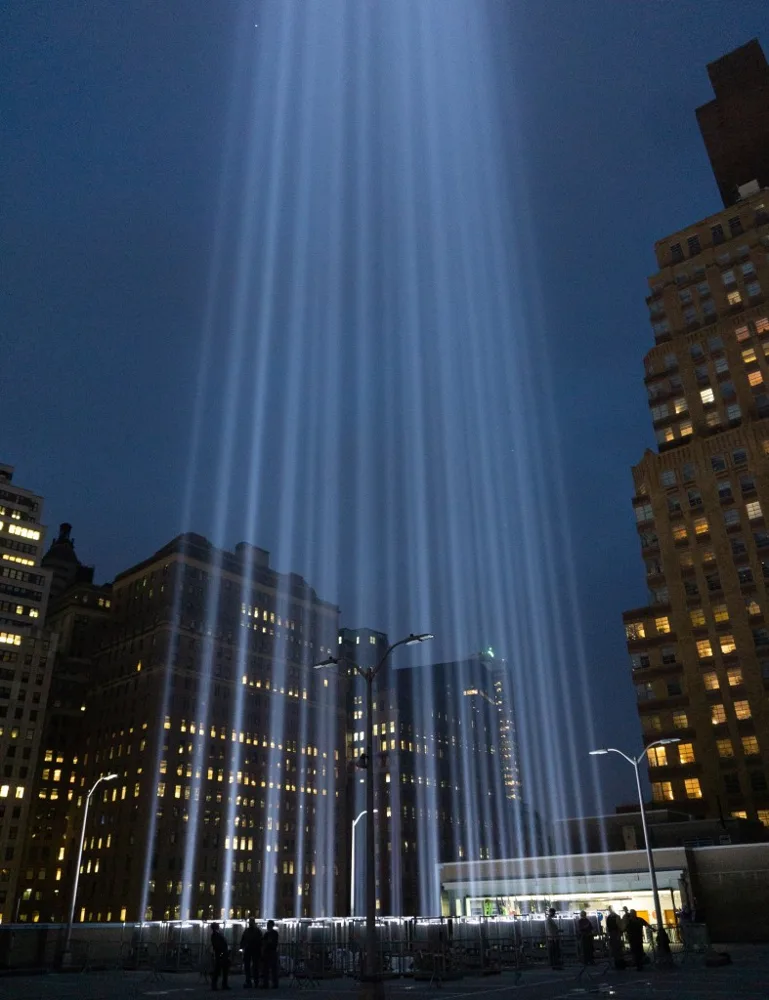
The “Lighting Memorial” ceremony in New York City is a powerful urban-scale memorial ritual, but it has raised concerns about migratory ecology. Volunteers track bird movements each year; when thousands of birds are caught in the light beams, the lights are temporarily turned off to prevent injury. Such protocols exemplify ethical management principles in commemorative lighting.
From darkness to light, from a minute when the sun shines to the glimmer of a silent pool, when designing the light-filled journey of a monument, architects and engineers are actually choreographing mourning itself. Light becomes a vehicle for meaning: A beam of light marking the exact moment of loss provides the rhythm for the memorial; a dimly lit room where a soft echo can be heard becomes a sanctuary of silence; the reflection doubling the flame of a candle symbolizes the enduring presence of the moment. We have seen how criteria such as sDA and RT60, or practices such as wildlife monitoring and light restrictions, translate these poetic intentions into meticulous designs. The best monument lighting is empathetic: it takes into account the needs of mourners adjusting to the darkness, the community seeking respect and solemnity, and even the birds in the sky. It is updated with the knowledge of each generation—as our understanding of ecology or psychology evolves, so do our monuments (monuments that can be completely closed during periods of high migration or adapted to visitor flow using sound and light to always create the right atmosphere of intimacy or togetherness are conceivable).
The goal is not to create a spectacle, but to illuminate the path from individual grief to collective hope. When done well, the light of remembrance gently guides people—it squeezes them in the darkness, allowing them to feel the depth of loss, then releases them into the light, allowing them to feel the possibility of healing. By using the cosmos, it reminds us that even stars and the sun are part of memories. It transforms absence into presence—an empty night sky into pillars of light, an empty chair into a lantern. It silences the noise of life, allowing silence to speak, yet when the time comes, the chorus of memories can echo. And it does all this by caring for the world around it, embodying the ethics of respect.
A person standing in front of a monument at dusk may notice how the last rays of the sun strike a name on the wall or how the reflection of a flame trembles on the water. At that moment, light connects sorrow and consolation. Architecture fades away, and what remains is a unity between the past and the present, between the living and the lost, between sorrow and its eventual transformation into memory. Light carries this burden with compassion, guiding us through the darkness and reconnecting us to life. It brings forth a resilient glow from the darkness—just as joy can emerge from sorrow, and community from solitude.
Through the careful arrangement of darkness and light, harmonizing with the rhythms of the sun and softened with ethical care, monuments are transformed from static tributes into living, breathing experiences. They greet us in our most fragile moments and, hand in hand with light, guide us toward meaning and comfort. In this way, light itself becomes a monument—always present, always gentle, reminding us every day (and every night) of the price of loss and the value of life.



